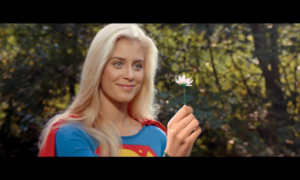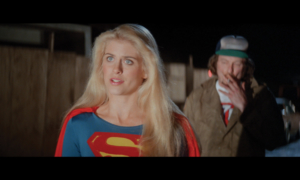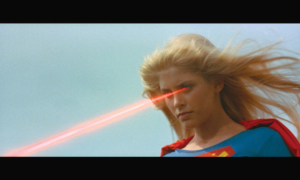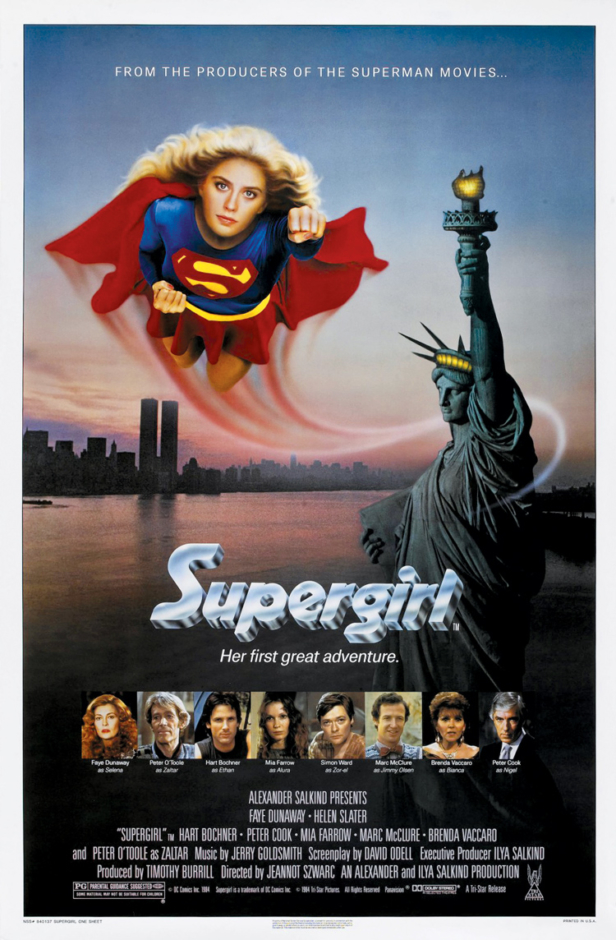For father and son producers, Alexander and Ilya Salkind, the Superman template appeared to be in place: cast a likeable unknown in the title role and surround them with established stars with considerable pulling power for support. It was a method that worked with the original 1978 Superman movie, so why shouldn’t it work for Supergirl’s first cinematic outing too?
While not a total disaster, Superman III brought in diminishing box office returns for the franchise during its release in the summer of 1983, and certainly appeared to be more of a comedic showcase for its co-star Richard Pryor than a bonafide entry for the Man Of Steel. Spinoff Supergirl was an attempt to refresh the franchise with a new face that might appeal to a different demographic.
“Tapping into the female audience was certainly part of it and also, especially, it was something different,” admits Ilya Salkind, producer behind the original Superman movies, to SciFiNow. “So, I came up with the idea of doing Supergirl instead of another Superman movie.”
Jaws 2 filmmaker, Jeannot Szwarc, was hired to helm Supergirl based on the box office success of that sequel and after both two-time Superman director Richard Lester and the legendary Robert Wise turned it down. Interestingly, Szwarc had directed Christopher Reeve four years earlier in the 1980 romantic sci-fi drama Somewhere In Time.
David Odell, who had notably written the screenplay for Jim Henson’s world-building fantasy adventure The Dark Crystal, penned what was to be a high-stakes story for Supergirl, where power-hungry prime antagonist Selena, ultimately achieved world domination. However, these considerable cinematic consequences were deemed too costly at the time.
“He wrote something pretty fantastic but it would have been a $200 million budget, so we had to cut it down as it was far too expensive,” continues Salkind. “In the Odell script Selena literally took over the world and that implied a lot more spending and special effects and all kinds of things, so we had to pair it down… I think we lost a lot of things that were very good but it would’ve been too expensive.”
An uncredited script doctor (ironically Earl Mac Rauch, the scribe behind the bombastic The Adventures Of Buckaroo Banzai Across The 8th Dimension), was appointed to tone down proceedings accordingly.

The basic premise centred around Superman’s younger cousin, Kara Zor-El, and her attempt to save her utopian society of Argo City (populated by Krypton fugitives) from doom after its power source, the Omegahedron, accidentally lands on Earth and slips into the hands of tyrannical sorceress Selena. After transforming into Supergirl during her journey to Earth, Kara assumes the identity of Linda Lee, cousin of Clark Kent and enrols at an all-girls school, where she befriends Lois Lane’s younger sister Lucy.
“Physically it’s not at all the prototype of a superhero the way Superman is,” observed Szwarc during Supergirl’s making- of documentary. “Superman was the man of steel and he’s big, he’s got muscles et cetera…she has superpowers [that] are the same…but where Superman is power and strength, [Supergirl] is more like style and elegance.”
Notwithstanding the story’s substantial threat to two very different home worlds, budget cutbacks significantly reduced Selena’s perceived global takeover to that of the minor occupation of an ‘all-American town’ (custom-built at Pinewood Studios), while in the interim, poor Supergirl is banished to the desolate Phantom Zone to banter depressingly with fallen Argo City founder Zaltar.
Despite the dreary, toned-down scope, there didn’t appear to be any expense spared on the cast. Faye Dunaway and Peter O’Toole headlined as Selena and Zaltar respectively, while Peter Cook, Brenda Vaccaro, Mia Farrow, Simon Ward, David Healy and future Die Hard actor Hart Bochner (in an amusing gender reversal of the traditional romantic female role), round out the colourful supporting cast. As the title character, 19-year-old newcomer Helen Slater made a suitably strong impact in her cinematic debut.
“We always ideally tried to have big stars surrounding an unknown,” admits Salkind. “Helen Slater was totally unknown at the time and when we tested her we had seen a lot of girls, including Demi Moore, who turned it down. But when we finally saw Helen she absolutely stole the show, so we decided to go with her.”
An interesting dynamic for this young, at first quite naïve superhero, is when she discovers that Earth is far from the serene and civilised utopia that she is used to back home. Therefore Kara chooses not to showcase her powers in public like her famous cousin does, instead undertaking her heroics with discretion.
Nevertheless, to become a physically convincing embodiment of the character, Slater trained for three months under the supervision of Alf Joint, the same stunt coordinator who helped Christopher Reeve become Superman. In fact, as Odell had originally envisioned, Supergirl would’ve linked more directly onscreen with her elder, equally airborne cousin. “In the original script, when she arrives on Earth, she was welcomed by [Superman] and there was this glorious sequence where they fly together,” reveals Szwarc enthusiastically on the DVD commentary. “But just before the film started Chris bowed out…”

Reeve’s role in the movie would have been significant too and perhaps more than just a passing of the torch. “In the Odell script, Superman is away on a mission and he actually grows old with Kryptonite and then somehow he regains his powers and comes to Earth to help Supergirl,” offers Salkind.
Instead, the Man Of Steel’s absence in the movie is explained via a radio announcement that proclaims Superman is away on a peace-seeking mission in another galaxy. Nevertheless, a casting connection was upheld with the return of Marc McClure, who had portrayed mild-mannered Daily Planet photographer Jimmy Olsen in all of the Christopher Reeve Superman films. In a twist to proceedings, Jimmy was now romantically linked with Lois Lane’s sister Lucy (played by Maureen Teefy) in Supergirl.
“I thought it was nice that you got to be with Jimmy around a girl that he liked,” McClure tells SciFiNow. “He’s just such a great guy, with so much eagerness to him and he’s someone who isn’t comfortable around the girls. The thing about Jimmy Olsen is that he’s an honest character and I always tried to make him as honest to himself as I could. So, it was nice to be asked to be the connection.”
Continuing the tradition of the big headline casting that had served the series well, Oscar-winning Faye Dunaway, who had previously worked on the Salkinds’ production of The Three (and Four) Musketeers, was cast as prime antagonist Selena – a mean, self-centered witch who lives in an abandoned spooky fairground attraction, complete with functioning ghost train, but has aspirations for global domination.
As Brenda Vaccaro, who played Selena’s softer comedic sidekick Bianca, suggested to SciFiNow, the notoriously volatile actress seemed somewhat suited for the part.
“She was obsessed by the way she looked, by her costume and by this horrible red wig that she had decided was right for the character,” laughs Vaccaro. “She also used to complain to the cinematographer: ‘Why don’t you light me like you light Brenda?’ Alan Hume was beyond patient and kind and treated her like the queen bee of all time; following Faye across the room with this light on her so that she was never without being lit. She certainly wasn’t a barrel of laughs that’s for sure!”
“I didn’t spend much time with Faye Dunaway… I know there was a rule: no talking or messing about when she took the set,” adds McClure. “I don’t know if that helped the project though. We were doing Supergirl not Chinatown and it deserved a little levity.”
Fortunately, legendary British comedian Peter Cook, who portrayed sarcastic schoolteacher and Selena’s fellow warlock mentor Nigel, helped to lighten up proceedings, while Vaccaro, who enjoyed working with Szwarc and the entire crew, had fun achieving an in-camera climatic effect where an empowered Selena literally puts Bianca in her place, after she tries to flee the turmoil.
“For the flying, you have this leather diaper thing on, then they hoist you up and you’re supposed to learn to fly,” recalls Vaccaro. “But for me they ended up picking me up and pulling me backward fast. I wish I had been able to fly but that’s basically what they ended up doing, to make me sort of disappear.”
Although Vaccaro, as the softer witch with a conscience, provides amusing commentary during Selena’s outlandish exploits, the actress wished she’d had a chance to broaden the relationship between the pair further.
“Maybe I would’ve been the nicest witch in a coven, and I certainly provided that contrast alongside [Selena], however I never got to develop anything with her,” she reflects. “[Faye] was such an insular character, an insular person – a selfish actress who was more interested in her costumes and how she looked… so, I did the best that I could without being able to really enhance the relationship.”
Despite noble intentions all-round, including a fresh, likable turn from a young Helen Slater in the title role and a triumphant and catchy theme from legendary composer Jerry Goldsmith, Supergirl didn’t reinvigorate the franchise the way the Salkinds had anticipated and it subsequently sank at the box office.

“The first week it was number one definitely, and then it kind of fell down,” laments Salkind. “I think the problem was we advertised it as ‘from the producers of Superman’ and perhaps we should have advertised it on its own.”
It wasn’t warmly received critically either. Although praising Slater, critics targeted the campy tone, flat direction and sometime ‘cheesy special effects’, in addition to some character inconsistencies, while Dunaway and O’Toole received Golden Raspberry Award nominations for their performances.
“There was just something missing and I think [Faye] was a problem,” considers Vaccaro. “She wasn’t campy, she wasn’t fun, she wasn’t like Anjelica Huston as Morticia… I don’t really know what the story was about either: ‘an old witch who wanted to destroy a good kid’. I don’t even know why [Selena] was against her that much. Why?”
Marc McClure also has mixed feelings and considers that the movie sorely missed the Richard Donner touch. “I liked Helen but the script kind of lost me and I think the direction kind of lost me a little bit too,” he reflects. “Jeannot Szwarc kind of made it campier than it should have been. I always think that with any comic book sequences you have to be really honest and treat the audience with respect… once you miss that mark the project starts to make fun of itself. Let the audience believe everything they want; don’t camp it up. Dick Donner was as good as it gets – he really believed in Superman.”
Fortunately, three decades on, a completely different cultural climate allowed for Supergirl’s potential as a bonafide female superhero to finally be realised through a hit TV series (2015-), in which Helen Slater sporadically appears as the titular character’s foster mother Eliza Danvers.
With the thriving success of both this and DC’s Wonder Woman, new possibilities have now paved the way for the early development of another cinematic outing and one rumoured to engage a female director – perhaps this alternative gender perspective will finally do Supergirl cinematic justice.
